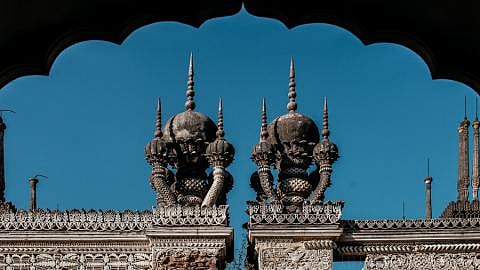

The Paigah nobility of the princely state of Hyderabad was founded in the 18th century by the brave soldier Abul Fateh Khan Tegh Jung Bahadur, said to be a descendent of the second Caliph of Islam. He was appointed to protect Nizam Ali Khan, the second Asaf Jahi ruler or Nizam of Hyderabad. He commanded an army called the ‘Paigah’ for the purpose, and the Nizam bestowed on him the hereditary title of ‘Paigah’. Paigah also means ‘right hand man’, which he certainly was to the Nizam. Another of his titles was ‘Shams-ul-Umra’ which meant, ‘the sun among the nobles’. His son Fakhruddin Khan married the Nizam’s daughter, and with that, began a tradition of the Paigahs marrying princesses from the Nizam’s family. They were second only to the Nizams in the aristocratic hierarchy.
The Paigahs were fiercely loyal to the Nizams and were responsible for the defence of the state. They were great patrons of art as well, and were known for erecting palaces all around Hyderabad. Their legacy lives on in beautiful buildings like the Paigah palace, the Asmangarh palace and many mansions in the old city, but their most famous contribution is the iconic Falaknuma Palace, built by Nawab Vikhar-ul-Umra Iqbal-ud-doula. The sixth Nizam Mahboob Ali Khan, the Nawab's brother-in-law, came to the palace to visit his sister. He loved the magnificent palace so much, that he bought it from the Nawab and lived there for the rest of his life.
Generations of nobles from this illustrious noble family are buried in a peaceful sanctuary on a small lane off the busy Santoshnagar main road.
The decrepit entrance to the necropolis betrays no hint of the magnificence inside. Easily the most exquisite structures in Hyderabad, the tombs are built in lime and mortar, in a combination of Asaf Jahi and Rajasthani styles of architecture. They are decorated with breathtaking perforated screens (called jaalis), carved doors and stucco work in floral and geometrical patterns, and are all open to the sky. Long corridors with arched alcoves flank the length of the complex. The graves themselves, are made of marble, often embellished with intricate inlay work.
The most important grave is that of the founder Paigah Abul Fateh Khan, covered with a silken shroud and offerings of fresh flowers. His is the first tomb in the complex and is separated from a simple and elegant mosque by a large ablution pond. Other prominent family members buried here include Nawab Fakhruddin Khan (you’ll know his grave by the hollow ostrich egg that hangs above it), Nawab Asman Jah, Nawab Iqbal-ud-doula, the builder of the Falaknuma Palace and the wives of various Nawabs. There is a separate enclosure with rows of small graves, where deceased Paigah children were buried.
Missing marble chunks, chipped stucco work, broken doors and gaping niches where precious stones used to be, are a sad reminder that time and vandals haven’t been kind to these delicate tombs. Things are looking up, however, as a lot of landscaping and restoration work has been undertaken in recent times.
Given the love that the Paigahs had for art, architecture, beauty and grandeur, it is fitting that they are surrounded by just that, even in death.
You can visit the Paigah Tombs between 10 AM and 5 PM on all days except Fridays and holidays. There is no entry fee. The complex is at the end of a small lane opposite to Owaisi Hospital.
Photos by Madhumita Gopalan